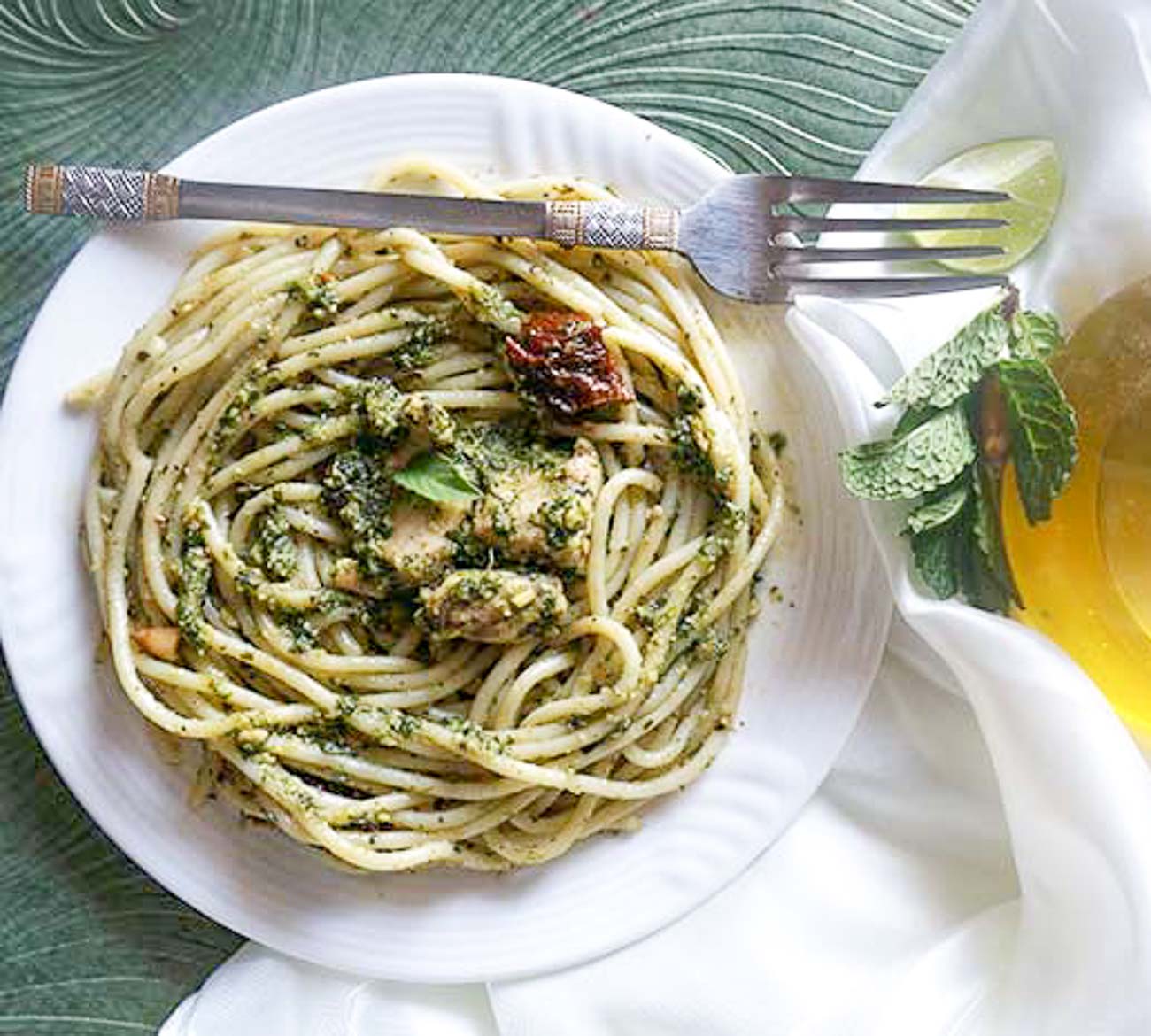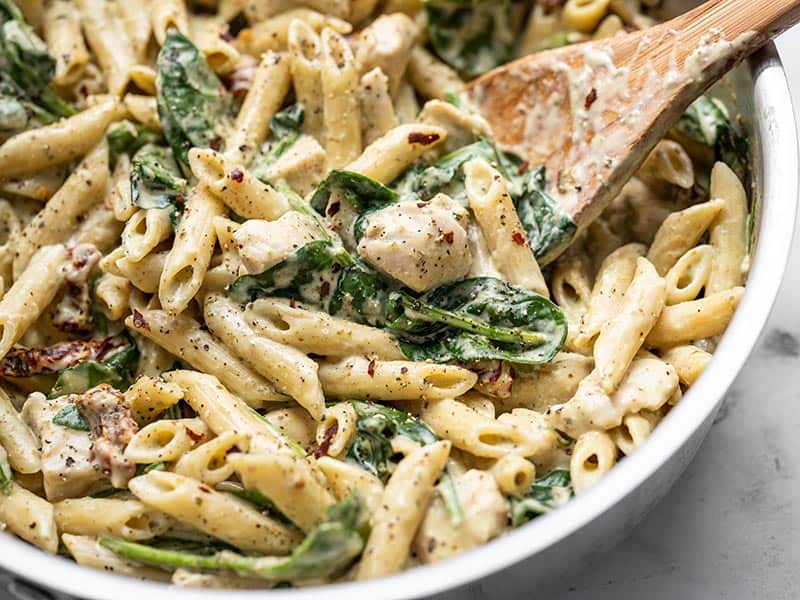Pesto pasta is a beloved dish that has captured the hearts of food enthusiasts worldwide. Its vibrant green hue, aromatic basil flavor, and creamy texture make it a culinary delight. In this comprehensive guide, we delve into the essential ingredients of pesto pasta, providing you with the knowledge and techniques to create this delectable dish at home.
From the aromatic basil to the nutty pine nuts and the sharp Parmesan cheese, each ingredient in pesto sauce plays a crucial role in delivering its distinctive flavor profile. Whether you’re a seasoned cook or just starting your culinary journey, this guide will equip you with the knowledge and inspiration to master the art of pesto pasta.
Introduction to Pesto Pasta

Pesto pasta is a delectable dish that has captured the hearts of food enthusiasts worldwide. Its origins can be traced back to the vibrant region of Liguria in Italy, where it has been a culinary staple for centuries. Pesto pasta is renowned for its vibrant green hue, aromatic fragrance, and tantalizing flavors that dance harmoniously on the palate.The
distinctive characteristics of pesto pasta lie in its use of fresh basil, pine nuts, garlic, and olive oil, which are blended together to create a flavorful pesto sauce. This sauce is then generously tossed with pasta, typically short shapes like trofie or trenette, resulting in a dish that is both visually appealing and incredibly satisfying.
Ingredients for Pesto Sauce
Pesto sauce is a vibrant, aromatic condiment that originated in the Liguria region of Italy. It’s typically made with fresh basil, pine nuts, garlic, Parmesan cheese, and olive oil. Each ingredient plays a crucial role in creating the sauce’s distinctive flavor and texture.
Key Ingredients
- Fresh Basil: The foundation of pesto, basil provides the sauce with its vibrant green color and herbaceous aroma. It’s important to use fresh, tender basil leaves for the best flavor.
- Pine Nuts: Pine nuts add a nutty, buttery flavor to the sauce. They can be toasted beforehand to enhance their flavor.
- Garlic: Garlic adds a subtle pungency and depth of flavor. Use fresh garlic cloves for the best results.
- Parmesan Cheese: Parmesan cheese provides a salty, nutty flavor and helps thicken the sauce. It’s recommended to use freshly grated Parmesan for the best texture.
- Olive Oil: Olive oil is the base of the sauce and provides richness and smoothness. Use a high-quality extra virgin olive oil for the best flavor.
Variations and Substitutions
There are several variations and substitutions that can be made to the classic pesto recipe. For example:
- Nuts: Instead of pine nuts, you can use walnuts, almonds, or cashews.
- Cheese: You can substitute Parmesan cheese with Pecorino Romano or Asiago cheese.
- Herbs: You can add other herbs to the sauce, such as parsley, cilantro, or mint.
- Oil: You can use other types of oil, such as avocado oil or walnut oil.
Steps for Making Pesto Sauce
Crafting a vibrant and aromatic pesto sauce is a culinary endeavor that demands precision and attention to detail. This guide will provide a step-by-step roadmap, equipping you with the knowledge and techniques to create an exceptional pesto that will elevate your culinary creations.
Before embarking on this culinary journey, it is imperative to gather the necessary equipment: a food processor or mortar and pestle, measuring cups and spoons, a sharp knife, and a large mixing bowl. The choice of equipment will influence the texture of the pesto, with a food processor yielding a smoother consistency while a mortar and pestle will produce a more rustic texture.
Ingredients
- Fresh basil leaves, washed and dried: The foundation of pesto, basil provides the vibrant green hue and herbaceous aroma.
- Garlic cloves, peeled and minced: Garlic adds a pungent and savory depth to the pesto.
- Pine nuts or walnuts, toasted: These nuts provide a nutty crunch and richness to the sauce.
- Grated Parmesan cheese: Parmesan adds a salty and umami flavor, enhancing the overall complexity of the pesto.
- Olive oil: Extra virgin olive oil is the preferred choice for pesto, providing a fruity and robust flavor.
- Salt and pepper: To taste, these seasonings balance the flavors and enhance the overall taste profile.
Method
Using a food processor or mortar and pestle, combine the basil, garlic, pine nuts, Parmesan cheese, and a generous drizzle of olive oil. Process or grind until the ingredients are finely chopped but not pureed, retaining some texture for a more flavorful experience.
Season the pesto with salt and pepper to taste, adding more olive oil if necessary to achieve the desired consistency. The pesto should be thick enough to coat pasta or vegetables but not overly runny.
Tips and Tricks
- For a brighter green pesto, use fresh basil leaves that have been recently harvested.
- Toasting the nuts enhances their flavor and adds a subtle crunch to the pesto.
- If you don’t have Parmesan cheese on hand, you can substitute it with Pecorino Romano or Asiago cheese.
- For a vegan pesto, omit the Parmesan cheese and use nutritional yeast instead.
- Store the pesto in an airtight container in the refrigerator for up to 5 days, or freeze it for longer storage.
Types of Pasta for Pesto

When selecting the perfect pasta for your pesto dish, it’s crucial to consider the shape, size, and texture of the pasta. Certain types of pasta are better suited to capturing the vibrant flavors and textures of pesto sauce.
Pesto’s creamy, herbaceous nature pairs well with pasta shapes that provide ample surface area for the sauce to adhere to. Short, stubby shapes like penne, orecchiette, and fusilli trap the sauce in their crevices, ensuring every bite is bursting with flavor.
Short Pasta
- Penne: Penne’s hollow, cylindrical shape and ridged exterior create the perfect canvas for pesto to cling to.
- Orecchiette: These small, ear-shaped pasta have a slightly chewy texture that complements the richness of pesto.
- Fusilli: Fusilli’s corkscrew shape provides plenty of nooks and crannies for the sauce to nestle into.
Long Pasta
- Spaghetti: Spaghetti’s thin, long strands are ideal for a light and flavorful pesto dish.
- Linguine: Linguine’s slightly flattened shape and long length make it a good choice for pesto that contains larger ingredients, such as vegetables or nuts.
Additional Ingredients and Toppings
Enhancing the flavor of pesto pasta is easy with a few additional ingredients. Consider adding sun-dried tomatoes, grilled chicken, or sautéed mushrooms for a burst of flavor.
Toppings and Garnishes
Top your pesto pasta with a variety of toppings to add complexity and visual appeal. Parmesan cheese, toasted pine nuts, and fresh basil add a classic touch. For a spicy kick, try adding red pepper flakes or chili oil. A drizzle of balsamic vinegar or lemon juice can brighten up the flavors.
Variations and Adaptations
Pesto pasta offers endless possibilities for creativity and customization. From experimenting with different sauces to adapting the recipe to suit dietary restrictions, there’s a pesto pasta variation for every taste and preference.
To enhance the flavor and complexity of your pesto pasta, consider using different types of pesto sauces. Arugula pesto, made with peppery arugula leaves, adds a zesty kick to the dish. Sun-dried tomato pesto incorporates sweet and tangy sun-dried tomatoes for a Mediterranean twist.
Roasted red pepper pesto imparts a smoky and vibrant flavor to the pasta.
Dietary Adaptations
For those with dietary restrictions, pesto pasta can be easily adapted. Gluten-free pasta is a suitable option for individuals with gluten intolerance or celiac disease. For a vegan pesto, replace the Parmesan cheese with nutritional yeast and use plant-based milk instead of dairy milk.
Creative Innovations
Beyond traditional pesto pasta, there’s a world of innovative possibilities to explore. Try adding grilled shrimp or roasted vegetables to your pasta for a hearty and flavorful meal. For a creamy and indulgent twist, stir in a dollop of mascarpone cheese or heavy cream to the pesto sauce.
Experiment with different types of pasta, such as penne or farfalle, to create a visually appealing and texturally diverse dish.
Closure
In conclusion, the ingredients of pesto pasta are a harmonious blend of flavors and textures that create a dish that is both satisfying and memorable. By understanding the role of each ingredient and experimenting with variations, you can tailor the recipe to your personal preferences and create a pesto pasta that will tantalize your taste buds and impress your guests.
So gather your ingredients, embrace your culinary curiosity, and embark on a journey to create the perfect pesto pasta.
Answers to Common Questions
What are the essential ingredients for pesto sauce?
The essential ingredients for pesto sauce are fresh basil leaves, pine nuts, Parmesan cheese, garlic, olive oil, salt, and pepper.
Can I substitute other nuts for pine nuts in pesto?
Yes, you can substitute pine nuts with other nuts such as walnuts, almonds, or pistachios.
How can I make my pesto sauce creamier?
To make your pesto sauce creamier, add a splash of cream or milk while blending.
What types of pasta are best suited for pesto?
Short, sturdy pasta shapes like penne, orecchiette, or fusilli are ideal for holding the pesto sauce.
What are some optional ingredients that can enhance the flavor of pesto pasta?
Optional ingredients that can enhance the flavor of pesto pasta include sun-dried tomatoes, grilled chicken, or roasted vegetables.
